Sobre este plano
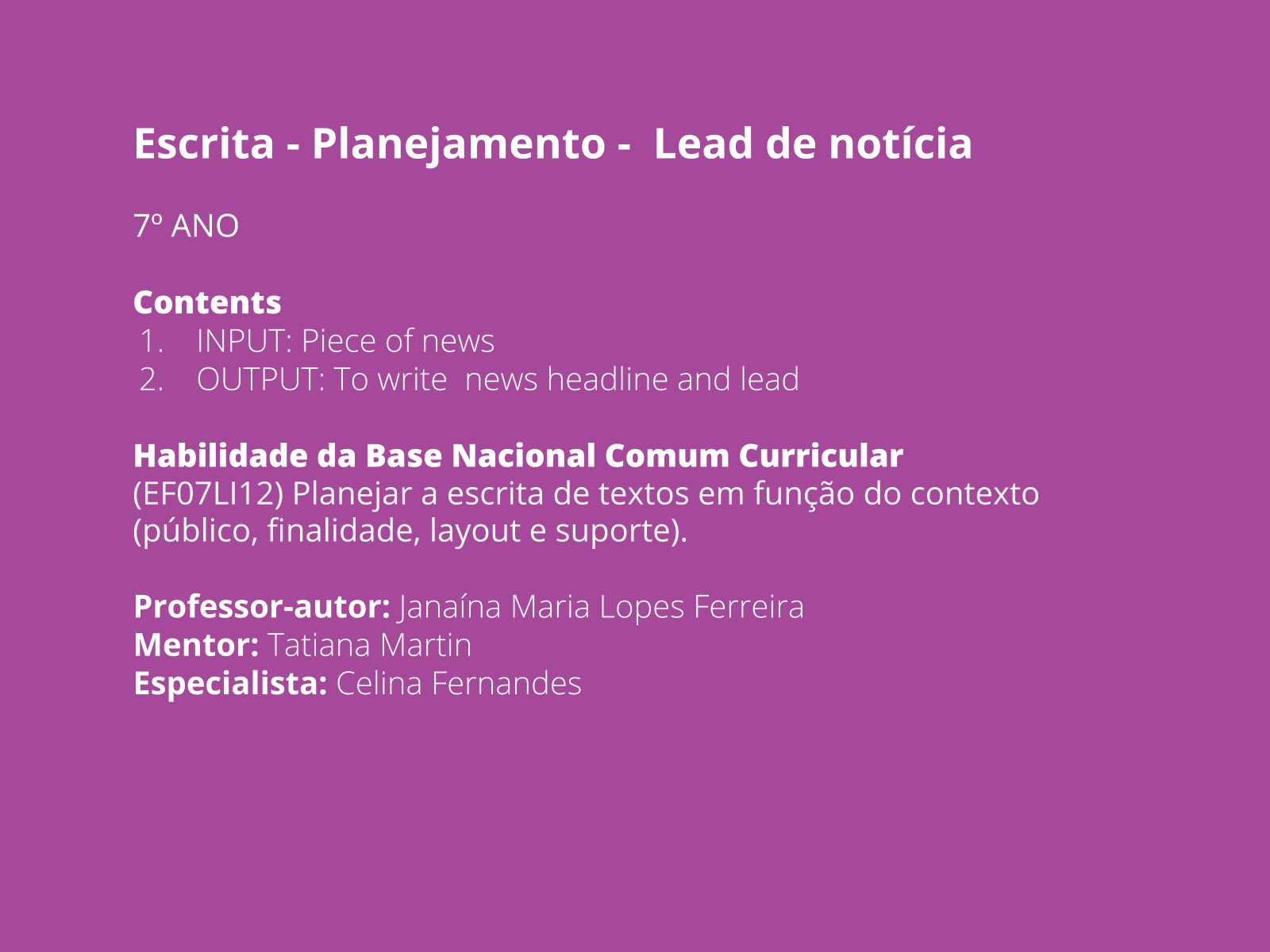
Este slide não deve ser apresentado para os alunos, ele apenas resume o conteúdo da aula para que você, professor, possa se planejar.
Preparação para a aula: Professor, você precisará de um computador e um datashow para expor os slides da aula. Porém, caso não possua esses recursos, pode imprimir os slides em tamanho grande e colar em cartolinas que deverão ser afixadas no quadro. Além disso, precisará de cópias no output, caso não seja possível uma para cada aluno, faça o mesmo já sugerido: cole em tamanho grande em cartolina e coloque no quadro.
Objective
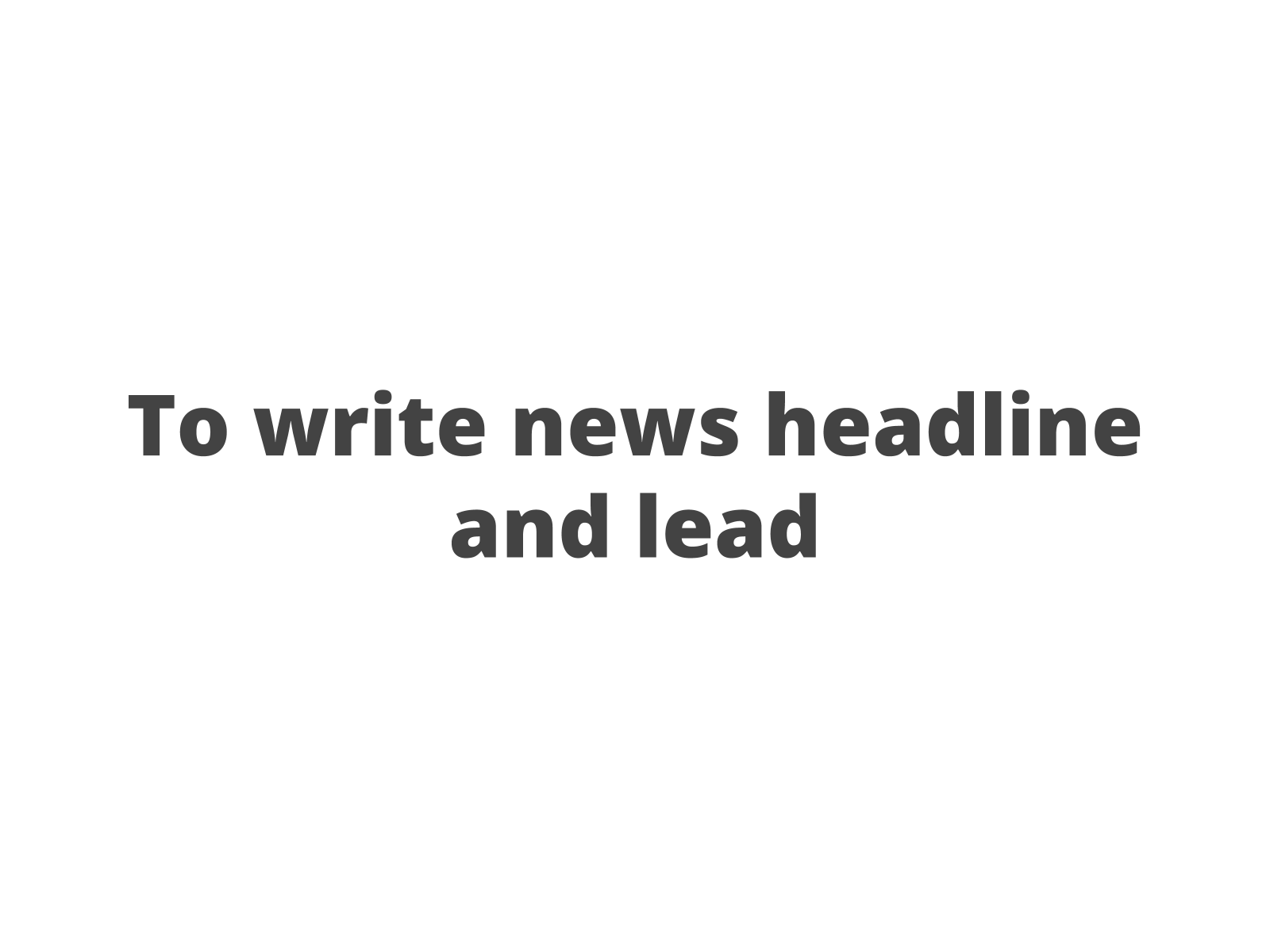
Tempo sugerido: 02 minutos.
Orientações: Mostre ou leia o objetivo para os alunos. Explique que eles irão trabalhar com o gênero notícia. Diga aos alunos: “Today we will read and write news headline and lead. “ Pergunte aos alunos: Do you know what a lead is ? Do you know what a headline is? Possíveis respostas: Yes, I do. I don´t know. No, I don´t .
Explique que a manchete é usada para chamar a atenção do leitor e o lead é o primeiro parágrafo de uma notícia e seu objetivo é auxiliar o leitor a decidir pela continuação ou não da leitura. Explique: “Headlines is the “title” of the news and it is responsible to arouse reader's curiosity. Lead is the first news’ paragraph and its aim is to help readers decide if they are going to continue the reading or not.
Context
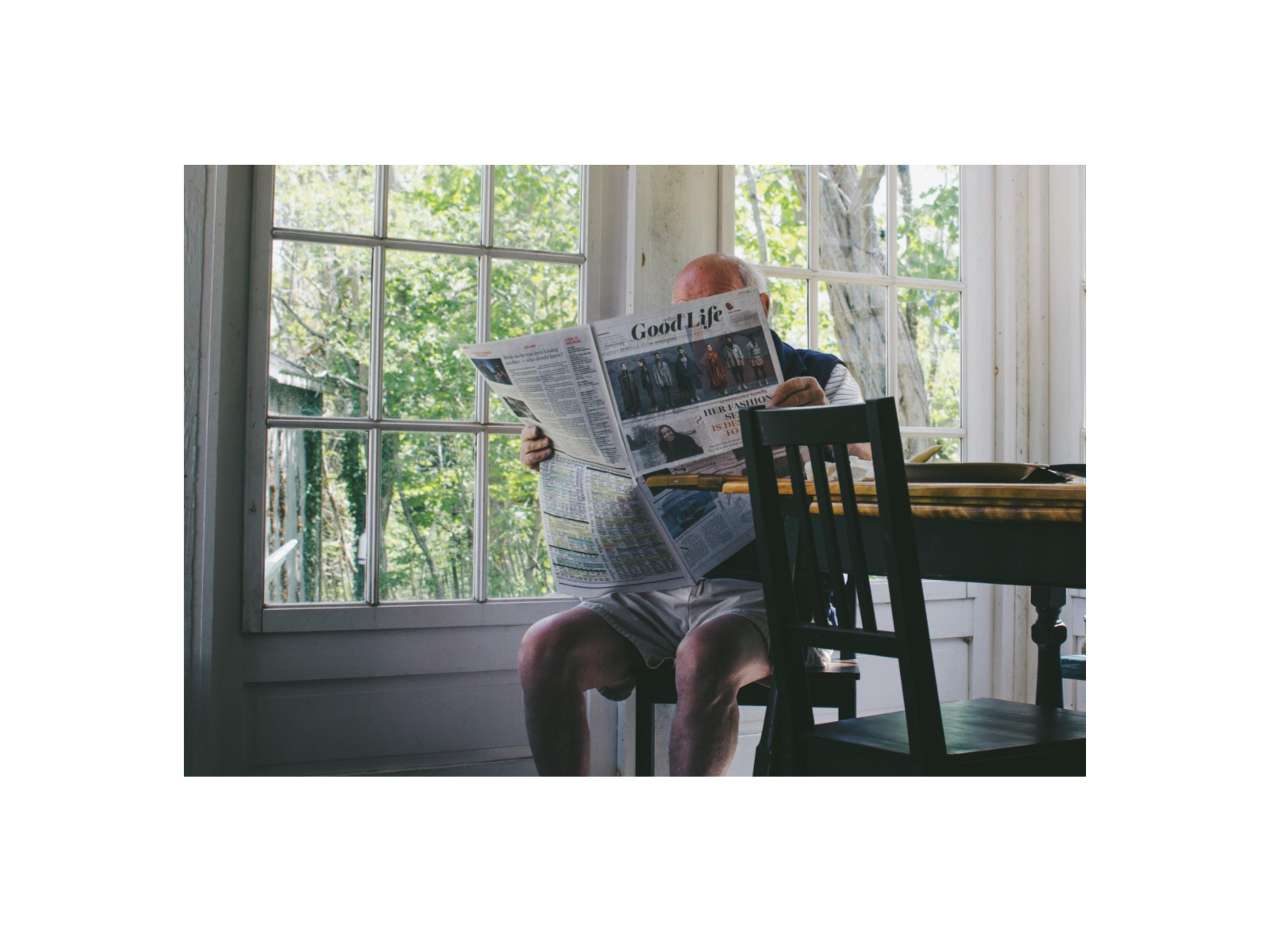
Tempo sugerido: 03 minutos.
Orientações: Mostre a imagens acima para os alunos. Pergunte aos alunos o que veem na imagem. Pergunte:
- Tell me, what can you see in this picture? Possíveis respostas: I can see a man reading a newspaper. An old man at home reading a newspaper.
- Do you read newspapers? Which one?
- Comente que as notícias são apresentadas de forma diferentes dependendo da intenção de cada jornal, há alguns mais sérios e outras mais sensacionalistas, por exemplo. Diga: I think that you know that the news is presented in different ways, depending the newspaper intentions, some are more serious and others are more sensationalists, like tabloids, for example.
- Explique que, como o jornal traz muitas notícias, não há tempo suficiente para ler todas. Por isso, existe a manchete ( para chamar a atenção) e o lide (para passar as informações mais diretas para o leitor). Com esses recursos, opta-se ou não pela leitura de determinada notícia. Diga: In one newspaper we can find many different news, there isn't enough time to read all of them. So, there are the headline ( to call the attention) and the lead (to show direct information to the reader). This way, we can choose to read or not determined news.
- Prepare os alunos para o trabalho com duas notícias a seguir. Diga: Let´s study two pieces of news and pay special attention to the headline and the lead.
Input
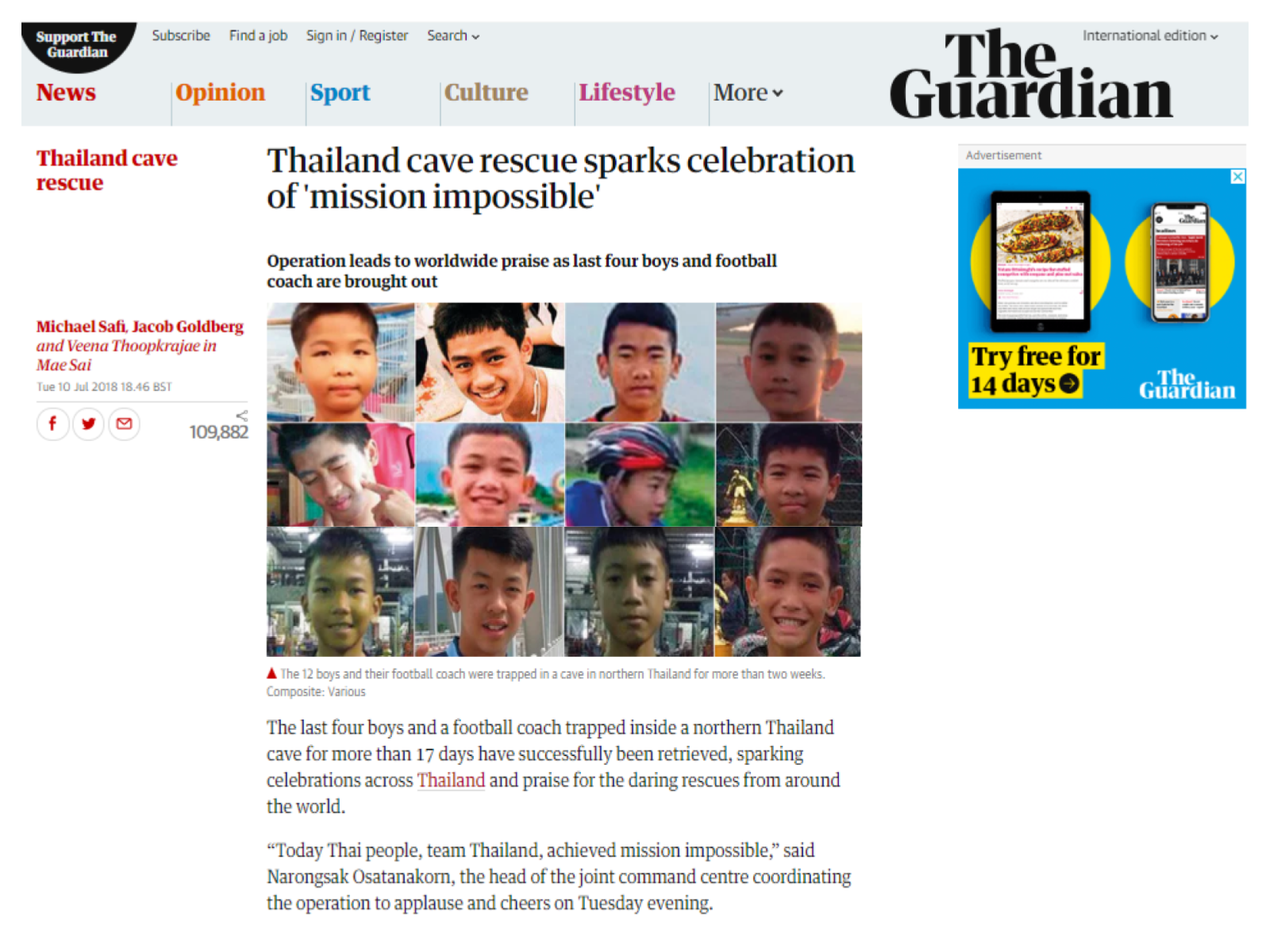
Tempo sugerido: 15 minutos - 8 minutos para o primeiro slide e 7 minutos para o segundo,
Propósito: Apresentar dois exemplos do gênero proposto.
Expectativa: Que os alunos reconheçam a função da manchete e do lide no gênero notícia.
Orientações:
- Mostre o slide aos alunos e faça algumas perguntas para explorar a imagem apresentada. Pergunte: Take a look at this image and tell me:
- Where was it published? How do you know that? Resposta: In an Internet site, probably it´s a page of journal; because of the layout of the page.
- What stands out in the picture? Resposta: The sentence “ Thailand cave rescue sparks celebration of ´mission impossible´”, and the boys´photos.
- The big letter in the beginning has an intention. Which one do you think it can be? Resposta: Probably call the attention of the reader.
- What is the journal responsible the news? Resposta: The Guardian. Explique que é um jornal diário britânico. Diga: The Guardian is a daily British Journal.
- When was it published? Resposta: July 10th 2018.
- Agora, inicie uma leitura mais detalhada do texto. Converse com os alunos para que decidam como será esta leitura: compartilhada, silenciosa, colaborativa etc). Diga: Let's decide how we are going read the text? We can share reading, read in silence, collaborate in reading, or another way you prefer.
- Feita a escolha do tipo de leitura, façam-na. Durante a leitura, combine que os alunos poderão interromper para esclarecer palavras desconhecidas. O importante é que leiam e entendam o que estão lendo (não precisam entender palavra por palavra, e sim a ideia geral). You can interrupt the reading if you don´t understand the meaning of any word. It’s important to read and understand the text. It's not necessary to understand word by word, but the general idea of the text.
- Feita a leitura, pergunte: What is the subject of this text? Resposta: It's about the rescue of the last four boys and a football coach who were retrieved in a cave.
- Pergunte: Can you tell me what kind of text is this? How do you know that? Resposta: It is news, because it's an informative text.
- Explique que a notícia é um gênero textual jornalístico, portanto um gênero informativo, cujo foco são eventos atuais. Diga: News is a journalist genre, so it's an informative text focusing on current events.
- Fale sobre a estrutura da notícia: título principal e auxiliar, lide e corpo da notícia. Enquanto fala sobre essa estrutura, aponte no slide cada uma das partes. Diga: The structure of news is the main and auxiliary title, lead and news body.
- Escreva no quadro: TITLES - LEAD - NEWS BODY. Depois, explique cada uma para que fique clara para os alunos a estrutura da notícia.
- Titles: the main title is also called headline (written in capital letters), it synthesizes the theme, and the auxiliary shows a piece of what will be showen in the reading.
- Lead : first paragraph of news, it´s the introduction. This paragraph must answer six questions: What? Who? When? Where? Why? How? The lead is very important because it shows all the information that will appear, and also because it will arouse reader's attention to the news reading. Trabalhe o lead da notícia com os alunos: What? The rescue in the cave. Who? The last four boys and the football coach. When? For 17 days. Why? Because they were retrieved. How? By the rescue.
- News body: it will show more details about the news presented.
9. Diga que agora irão estudar mais uma notícia no próximo slide, cujo foco também será tecnologia. Diga: In the following slide, we will identify two parts of the news: the headline and the lead. Besides that, we will practice the structure of the lead, finding answers for its six questions.
Link para a notícia completa aqui.
Input

Orientações:
- Solicite aos alunos que observem a imagem apresentada no slide que leiam em silêncio a reportagem apresentada. Dê 2 minutos para eles. Diga: Observe the image and read the news in silence. You have 2 minutes for that.
- Esclareça que o objetivo agora é focar na manchete e no lead. Explique: The goal is to focus on the headline and on the lead.
- Pergunte sobre a manchete: What's the headline in this news? Resposta: Don't see any reason to part ways with Constantine till Asian Cup.
4. Agora, faça as seis perguntas do lead para que os alunos respondam oralmente. Diga: According to the lead, answer:
- What? Resposta: The work continuation of India´s national football coach.
- Who? Resposta: India´s national football coach: Stephen Constantine.
- When? Resposta: At least till the 2019 Asian Cup.
- Where? Resposta: In India.
- Why? Resposta: To rest speculations.
- How? Resposta: Keeping Stephen´s job.
5. Prepare os alunos para o output. Diga-lhes que a atividade seguinte pedirá foco na manchete e no lead. Diga: Now, let's write! The following slide will bring a photo and based on it you will create the beginning of the news: the headline and the lead.
Para ler a notícia completa, acesse:
https://timesofindia.indiatimes.com/sports/football/top-stories/dont-see-any-reason-to-part-ways-with-constantine-till-asian-cup-aiff/articleshow/65322271.cms
Output
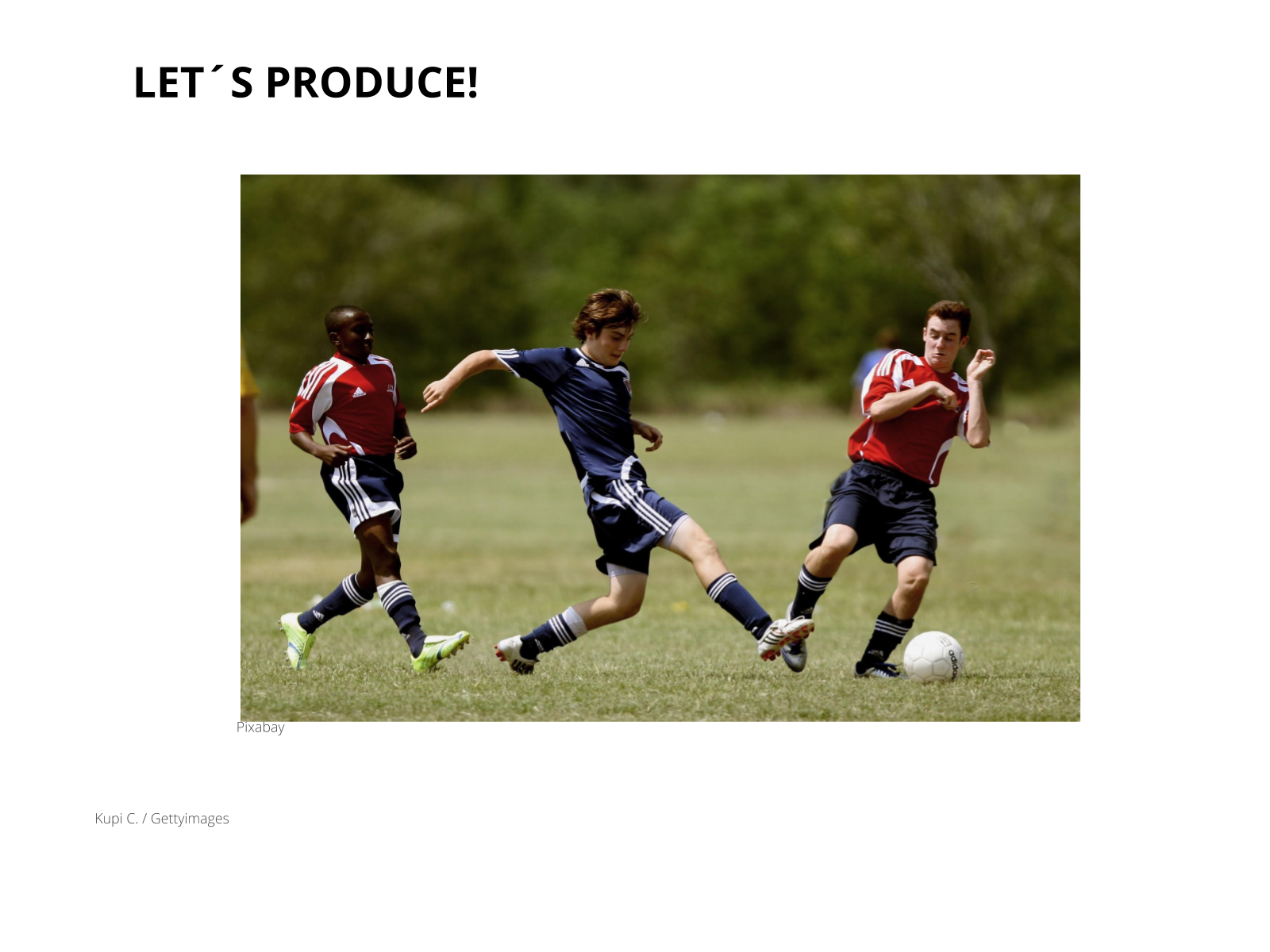
Tempo sugerido: 27 minutos.
Propósito: Escrever a manchete e o lead de uma notícia relacionada a imagens do slide.
Expectativa: Que os alunos escrevam uma manchete atrativa e que o lide responda as suas seis perguntas trabalhadas no input.
Orientações: Solicite aos alunos que observem atentamente a imagem acima. Pergunte:
- Can you observe any relation among this image and the other two news we have worked with? Resposta: Yes, they are about sport players.
- What does this image represent? Resposta: It represents a soccer game.
- Now, imagine that you are a newspaper writer and your task is to write about a soccer game.
- You can use your imagination: which are the teams? What happened before, during or after the game? Where was it? Your news can be about an accident, a happy moment, someone feeling bad, someone disappearing, problems with arbitration, and so on.
- Write an attractive headline;
- Write a lead answering the questions: What?, Who?, When?, Where?, Why? and How?.
- Quando terminarem, cada aluno escolherá um(a) colega para corrigir sua manchete e seu lead, usando a checklist disponível.
Feedback
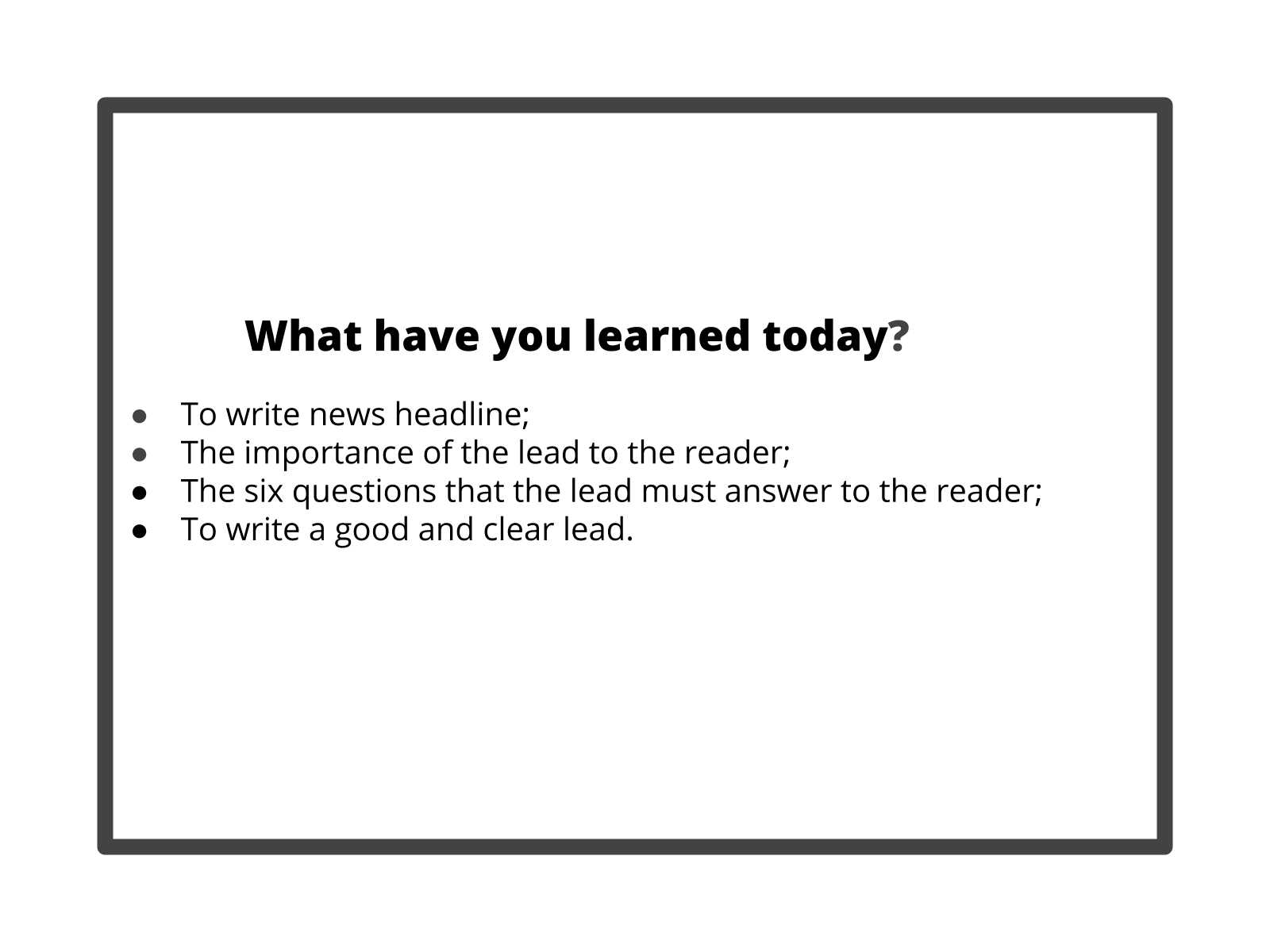
Tempo sugerido: 3 minutos.
Propósito: Organizar as ideias apresentadas na aula.
Expectativa: Que os alunos entendam a importância de se escrever bem uma manchete e o lead.
Orientações: Mostre aos alunos o quadro acima e com a síntese do que aprenderam na aula. Caso eles tenham mais comentários para fazer, anote-os e enriqueça o slide. Diga:
- Here we have a learning list about our class today. Do you agree? Can you point other learning issues?
